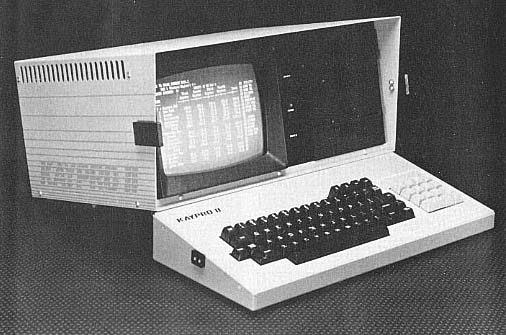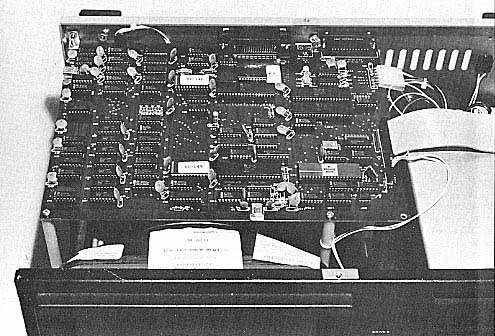Time waits for no man and certainly for no
microcomputer reviewer. Since this review was completed, Non-Linear
Systems has revamped its produce line for 1983 with two new system
configurations (the Kaypro 4 and Kaypro 10), new software offerings,
and a different pricing structure. The now "venerable" Kaypro II is
quite a bargain because NLS recently dropped its suggested retail
price to $1595, a $200 reduction.
The Kaypro 4 is
essentially an upgrade of the earlier model. Like its forebear, the
Kaypro II, the Kaypro 4 is a portable, CP/M-based system with 64K
bytes of RAM and two double-density floppy disk drives. The three
major differences are that (1) it has double-sided disk drives (each
offers 380K bytes of storage), (2) it is packaged in a dark gray
case, and (3) it costs $1995. A minor, if inexplicable difference,
is in the product name. NLS has shifted from using roman numerals
(e.g., II) to arabic numerals (e.g., 4) - a change not without
historic precedent.
The big news is the Kaypro 10, which
incorporates an internal 10-megabyte hard disk as well as one
double-sided, double-density, half-height floppy-disk drive (380K
bytes of storage). The Kaypro 10 itself is an upgrade of the Kaypro
5, a 5-megabyte hard-disk portable shown in 1982 but never produced
in quantity. The Kaypro 10, including software, will put you back
only $2795.
First, let's look at the hard disk. The physical
10-megabyte disk is divided into two logical devices of 5 megabytes
each, called drives A and B. The 5 1/4-inch floppy-disk drive is
drive C. Drives A and B are each subdivided into 16 user areas
(i.e., AO, Al,... A15 and BO, B1,...B15). As delivered from Kaypro,
the unit has the following files recorded on the hard disk:
User 0: Kaypro and CP/M utility programs
User 1: Perfect
Writer word-processing program
User 2: Profitplan electronic
spreadsheet
User 3: Perfect Calc electronic spreadsheet
User 4: Perfect Filer/Individual Member Data Base
User 5:
Perfect Filer/Organizational Member Data Base
User 6: S-BASIC
User 7: MBASIC and Games You can add or delete files to
suit your needs as long as you stay within the 5-megabyte limit per
logical drive. Note that user areas do not have predefined storage
limits - each user area takes from the 5-megabyte common pool.
One file, SAFETY.COM, is hard-disk-specific. Before ending a
session with the Kaypro 10, run the SAFETY program. This utility
moves the hard disk's read/write heads to an unused area of the hard
disk prior to powerdown. |
Therefore, even if the heads were to hit the surface
of the hard disk, no damage would occur to an area on which data was
stored. Running this program is a must for those who will be taking
the Kaypro 10 out into the real world and a should for the rest of
us. (It would have been nice if this procedure had been incorporated
into an automatic shutdown process.)
Aside from the single
drive, the exterior of the Kaypro 10 looks much like its
predecessors, especially the Kaypro 4. Both systems share the same
no-nonsense, gunmetal-gray cabinet and all-black keyboard. One
welcome addition is an integral wire stand for the front of the unit
that tilts the display up to a comfortable viewing angle. Also, the
carrying handle has been redesigned to be more compact. Because of
the hard disk, the designers included a fan for cooling the interior
components. The whole system weighs 31 pounds, as compared with 26
pounds for the Kaypro 4.
The back panel shows evidence of
some changes also: the power cord is removable, there are connectors
for one parallel port and two serial ports (one printer and one
modem), there is a jack for a light pen, the brightness control has
been moved to the back, and the Reset button has been moved to a
more accessible location. In addition to the 80- by 25-character
display, the Kaypro 10 has these graphics capabilities: draw/erase a
line, draw/erase a pixel, inverse video, half-intensity, blinking,
graphics characters (2- by 4-pixel matrix), cursor positioning, and
cursor on/off. The display is treated as a matrix 100 pixels high by
160 pixels wide. S-BASIC has special commands that draw geometric
figures such as circles, rectangles, squares, and bars.
Non-Linear Systems includes a prodigious amount of
applications software with each system. In addition to all of the
programs supplied with the Kaypro II, the firm is offering Wordstar
as an option to the Perfect Writer program. There is also a new
utility that will read and write disks in the formats of several
other popular computer systems - at the moment, it can transfer data
to and from the Osborne 1, the Xerox 820/II, and the TRS-80 Model I.
There is reason to believe that another 10 or more formats are on
the horizon.
Arthur A. Little is a technical editor for BYTE.
|


